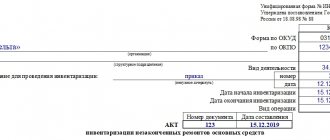To ensure the reliability of accounting and reporting data, organizations are required to conduct an inventory of property and liabilities, during which their presence, condition and valuation are checked and documented.
An inventory may be required due to the following events:
- when changing financially responsible persons;
- before preparing annual financial statements;
- when facts of theft, abuse or damage to property are revealed;
- during reorganization or liquidation of the company;
- in the event of a natural disaster, fire or other emergency situations caused by extreme conditions;
- in other cases provided for by law (Article 12 of the Federal Law of November 21, 1996 No. 129-FZ “On Accounting”, hereinafter referred to as Federal Law No. 129-FZ).
Let us remind you that the inventory is regulated by the following regulations:
- Federal Law No. 129-FZ;
- Regulations on accounting and financial reporting in the Russian Federation (approved by order of the Ministry of Finance of Russia dated July 29, 1998 No. 34n, hereinafter referred to as the Regulations);
- Methodological guidelines for inventory of property and financial obligations (approved by order of the Ministry of Finance of Russia dated June 13, 1995 No. 49, hereinafter referred to as Methodological guidelines).
Let’s assume that a financially responsible person in a company is leaving. In this case, an inventory is required. Let's consider what actions an accountant should take.
To carry out the inventory, a permanent inventory commission is created. It includes representatives of the organization’s administration, accounting workers, and other specialists (for example, engineers or economists).
It is important to know
All property of the organization is subject to inventory: intangible assets, fixed assets, cash and other assets. As well as rented or stored property and property that is not taken into account for any reason.
The head of the company issues an order to carry out an inventory (in form No. INV-22) and hands it over to the inventory commission. The order, as a rule, specifies the procedure, which objects are subject to inspection, the timing of the inventory of the object, the reason for which it is carried out, the composition of the commission and other information.
Inventory results are compiled:
- inventory list according to form No. INV-1;
- matching statement in form No. INV-18. It reflects discrepancies between accounting data and the inventory list. The characteristics of the OS, their passport data, year of manufacture, number are displayed. It is drawn up in two copies, one of which is stored in the accounting department, and the second is transferred to financially responsible persons;
- a final statement of accounting for the results identified by the inventory, according to form No. INV-26.
An example of filling out these forms is provided at the end of the article.
What is inventory?
Inventory is one of the procedures for monitoring the safety of company property.
Its essence is in comparing the actual availability of valuables (money, equipment, buildings, as well as liabilities) with accounting data. The procedure for conducting an inventory of fixed assets is regulated by the following legislative acts:
- methodological guidelines for inventory of property and financial obligations (Order of the Ministry of Finance dated June 13, 1995 No. 49);
- regulations on accounting and accounting in the Russian Federation (Order of the Ministry of Finance dated July 29, 1998 No. 34n);
- Law “On Accounting” dated December 6, 2011 No. 402-FZ.
The company must conduct an inventory not only of its own property, but also of stored or leased property. The inventory is carried out at the location of the property and in the presence of the financially responsible person or the team leader, if we are talking about collective financial responsibility.
Inventory: step-by-step instructions
How to take inventory? We bring to your attention step-by-step instructions for conducting this key event.
Preparing and conducting an inventory requires compliance with the provisions of Federal Law dated December 6, 2011 No. 402-FZ “On Accounting” (hereinafter referred to as the Accounting Law), as well as the Regulations on Accounting and Financial Reporting in the Russian Federation (approved by order of the Ministry of Finance of Russia dated July 29 .1998 No. 34n, hereinafter referred to as Regulation No. 34n).
The procedure for conducting an inventory of property and financial obligations of an organization and recording its results are defined in the Guidelines for the inventory of property and financial obligations (approved by Order of the Ministry of Finance of Russia dated June 13, 1995 No. 49, hereinafter referred to as the Guidelines for Inventory).
Unified forms of documents for registration of inventory results were approved by the State Statistics Committee (Resolution of the State Statistics Committee of Russia dated August 18, 1998 No. 88, dated March 27, 2000 No. 26).
The use of these regulations will allow you to correctly draw up all the documentation necessary as part of the inventory and comply with all the requirements of current legislation.
Inventory. Frequency
Inventory must be carried out (clause 3 of article 11 of the law on accounting, clause 27 of regulation No. 34n):
- before drawing up annual financial statements, excluding property, the inventory of which was carried out starting from October 1 of the reporting year. An inventory of fixed assets (FPE) can be carried out once every three years;
- when changing financially responsible persons. In this case, an inventory of the property that was entrusted to this person is carried out;
- when facts of theft or damage to property are revealed;
- if there was a natural disaster, fire, or other emergency situation;
- during liquidation or reorganization.
Inventory. "Road map"
Here are the necessary inventory steps:
Step No. 1. Create an inventory commission.
Step No. 2. We receive current incoming and outgoing documents.
Step No. 3. We receive receipts from financially responsible persons.
Step No. 4. We check and document the existence, condition and valuation of assets and liabilities.
Step No. 5. We reconcile the data in inventory records (acts) with accounting data.
Step No. 6. Summarize the results of the inventory.
Step No. 7. Approve the inventory results.
Step No. 8. Reflection of inventory results in accounting.
Step No. 1. How to create an inventory commission
The creation of an inventory commission is formalized by order (resolution, resolution) of the head of the organization (clause 2.3 of the guidelines for inventory).
The unified form of this order (form No. INV-22) was approved by Decree of the State Statistics Committee of Russia dated August 18, 1998 No. 88.
Any employee of the organization can be included in the inventory commission. As a rule, the members of the commission are:
- representatives of the organization's administration;
- accounting service employees (for example, chief accountant, deputy chief accountant, site accountants);
- other specialists - employees of technical (for example, an engineer), financial (for example, the head of a financial department), legal (for example, a lawyer) and other services.
Attention: financially responsible persons cannot be members of the inventory commission. At the same time, their presence when checking the actual availability of property is mandatory.
The commission must have at least two people.
The order, in addition to the composition of the inventory commission, must indicate the timing and reasons for conducting the inventory, the property being inspected and obligations.
The order is approved by the general director, after which the document must be signed by the chairman and members of the inventory commission.
The order to carry out an inventory is registered in the journal for monitoring the implementation of orders (decrees, instructions) to carry out an inventory, which can be drawn up in form No. INV-23 (clause 2.3 of the guidelines for inventory).
Step 2. We receive current incoming and outgoing documents
Before checking the actual availability of property, the inventory commission must obtain current receipts and expenditure documents, the latest on the day of the inventory.
The received documents are certified by the chairman of the inventory commission with the indication “before the inventory on “__” __________ 201_.” This is the basis for the accounting department to determine the balance of property at the beginning of the inventory according to accounting data (clause 2.4 of the guidelines for inventory).
Step 3. We receive receipts from financially responsible persons
A receipt issued by the financially responsible person before the start of the inventory is provided to the inventory commission on the day of the inspection. This document confirms that:
- by the beginning of the inventory, all expenditure and receipt documents for the property were handed over by the financially responsible person to the accounting department or transferred to the commission;
- all assets received under their responsibility are capitalized, and those disposed of are written off.
Step No. 4. We check and document the existence, condition and valuation of assets and liabilities
The inventory commission determines:
- names and quantities of property (fixed assets, inventories, cash on hand, documentary securities) available in the organization, including leased property, by physical counting (clause 2.7 of the inventory guidelines). At the same time, the condition of these objects is checked (whether they can be used for their intended purpose);
- types of assets that do not have a tangible form (for example, intangible assets, financial investments) - by reconciling documents confirming the organization’s rights to these assets (clauses 3.8, 3.14, 3.43 of the inventory guidelines);
- composition of receivables and payables - by reconciling with counterparties and checking documents confirming the existence of an obligation or claim (clause 3.44 of the inventory guidelines).
The inventory commission enters the received data into inventory records (acts).
After this, financially responsible persons must sign in the inventory records (acts) that they were present during the inventory (clauses 2.4, 2.5, 2.9 - 2.11 of the guidelines for inventory).
Step 5. Reconciliation of data in inventory records (acts) with accounting data
The received data in inventory records (acts) is verified with accounting data.
It happens that during the inventory, surpluses or shortages are identified. In this case, a matching statement is drawn up, which indicates the discrepancies (surplus, shortage) identified during the inventory. A matching statement is compiled only for those assets for which deviations from the accounting data have been identified.
To document the conduct and results of the inventory, you can use the following forms of documents:
- for OS - Inventory list of OS (form No. INV-1) and Comparison sheet of inventory of OS (form No. INV-18);
- for goods and materials - Inventory list of inventory items (form No. INV-3), Inventory report of shipped inventory items (form No. INV-4) and Comparison sheet of inventory results of inventory items (form No. INV-19);
- for Deferred Expenses - Inventory report of deferred expenses (Form No. INV-11);
- at the cash desk - Cash Inventory Report (Form No. INV-15);
- for securities and BSO - Inventory list of securities and forms of strict reporting documents (form No. INV-16);
- for settlements with buyers, suppliers and other debtors and creditors - Inventory report of settlements with buyers, suppliers and other debtors and creditors (form No. INV-17).
Step No. 6. Summarize the inventory results
At the meeting following the inventory, the commission:
- analyzes identified discrepancies;
- offers ways to resolve detected discrepancies in the actual availability of values and accounting data (clause 5.4 of the guidelines for inventory).
The meeting of the inventory commission is documented in minutes.
If the results of the inventory do not reveal any discrepancies, then this fact should also be reflected in the minutes of the meeting of the inventory commission.
Following the meeting, the inventory commission summarizes the results of the inventory, using
For this purpose, the unified form No. INV-26 “Record of results identified by inventory” can be used (approved by Resolution of the State Statistics Committee of Russia dated March 27, 2000 No. 26). It reflects all identified surpluses and shortages, and also indicates the method of reflecting them in accounting (clause 5.6 of the inventory guidelines).
The minutes of the meeting of the inventory commission, together with the results record sheet, are submitted for consideration to the head of the organization, who makes the final decision.
Step No. 7. Approve the inventory results
The inventory commission submits to the head of the organization the minutes of the meeting of the inventory commission and a record of the results identified by the inventory.
Matching statements and inventory lists (acts) may be attached to these documents.
After reviewing the documents, the head of the organization makes a final decision, which is formalized by an order approving the inventory results (clause 5.4 of the inventory guidelines).
A mandatory part of the order is an instruction on the procedure for eliminating discrepancies identified by the inventory.
After this, the documentation on the inventory results is transferred by the inventory commission to the accounting service.
Step 8. Reflection of inventory results in accounting
Discrepancies identified during the inventory between the actual availability of objects and the data of the accounting registers should be reflected in the accounting records in the reporting period to which the date as of which the inventory was carried out (Part 4, Article 11 of the Accounting Law).
In the case of an annual inventory, the specified results must be reflected in the annual financial statements (clause 5.5 of the guidelines for inventory).
If, as a result of an inventory, property is identified that is not subject to further use due to obsolescence and (or) damage, such property must be written off from the register.
Also, debts with an expired statute of limitations are written off from the balance sheet.
Based on the results of the inventory, a shortage was identified
In accounting, shortages are reflected on the date as of which the inventory was taken (Clause 4, Article 11 of the Accounting Law).
The cost of acquiring missing inventories is attributed to costs associated with production or sale, within the limits of natural loss rates (subparagraph “b”, paragraph 28 of regulation No. 34n). The postings will be like this:
Debit 94 Credit 10 (41, 43)
— the cost of lost property is written off;
Debit 20 (25, 26, 44) Credit 94
— the shortage is written off within the limits of natural loss norms.
The cost of shortages of inventories in excess of the norms of natural loss and shortages of inventories for which such norms are not approved, as well as shortages of fixed assets, tools, money and monetary documents (BSO, etc.) (subparagraph “b” of paragraph 28 of Regulation No. 34n) or recovered from the guilty person (if such a person is identified), or written off as other expenses (if the guilty person is not identified).
Debit 94 Credit 01 (10, 41, 43, 50)
— the cost of lost property is written off;
Debit 73 (76) Credit 94
— the cost of shortages is attributed to the guilty parties;
Debit 50 (51, 70) Credit 73 (76)
— the cost of the shortage has been recovered from the guilty party;
Debit 91 Credit 94
— excess shortages are written off as expenses.
For income tax purposes, the cost of acquiring missing inventories is taken into account in material costs during the period when the shortage is identified within the approved norms of natural loss (subclause 2, clause 7, article 254 of the Tax Code of the Russian Federation).
The procedure for accounting for shortages of inventories in excess of the norms of natural loss and shortages of inventories for which such norms are not approved, as well as shortages of fixed assets, instruments, money and monetary documents (BSO, etc.) depends on the situation.
Situation 1: the person responsible for the shortage has been identified
In this case, the cost of the shortage is taken into account in expenses for one of the following dates (subclause 8, clause 7, article 272 of the Tax Code of the Russian Federation):
- or recognition of the amount of damage as guilty (for example, on the date of concluding an agreement with the employee on voluntary compensation for damage);
- or the entry into force of a court decision to recover the amount of damage from the perpetrator.
At the same time, the income must take into account the amount of damage found guilty or awarded by the court (clause 3 of Article 250, subclause 4 of clause 4 of Article 271 of the Tax Code of the Russian Federation).
Situation 2 The person responsible for the shortage has not been identified
Then the cost of shortages is taken into account in expenses on the date of drawing up one of the following documents (subclauses 5, 6, clause 2, article 265 of the Tax Code of the Russian Federation):
- or a decision to suspend the preliminary investigation in a criminal case due to the fact that the person to be charged as an accused has not been identified;
- or a document from the competent authority confirming that the shortage was caused by an emergency.
For example, in the event of a fire, such documents will be a certificate from the fire service (EMERCOM), a fire report and a protocol for examining the scene of the incident.
If the inventory reveals surplus
The market value of surplus property identified as a result of the inventory is included in accounting and tax accounting as part of income as of the date on which the inventory was carried out:
The market value of such property can be confirmed by one of the following documents:
- or a certificate compiled by the organization itself based on available information on prices for the same property (for example, from the media);
- or a report from an independent appraiser.
The accounting entry will be as follows:
Debit 01 (10, 41, 43, 50) Credit 91
— surpluses identified during inventory are reflected.
Audit Department of RIGHT WAYS LLC
At least when should inventory be taken?
An inventory of fixed assets should be carried out at least once every 3 years, and of library collections at least once every 5 years (clause 1.5 of the Guidelines for the inventory of property and financial obligations).
The exact timing of inventory is determined by the company independently. As a rule, an asset inventory is carried out before annual reporting. However, the law establishes cases in which a company is obliged to conduct an inventory:
- transfer of property for rent;
- reorganization;
- liquidation;
- sale of property;
- change of financially responsible persons or team leader (as well as at the request of team members or when more than half of its members leave the team - for participants in a collective responsibility agreement);
- establishing facts of theft, abuse, damage to property;
- before preparing financial statements for the year;
- emergencies.
Let's study the procedure for conducting an inventory of fixed assets.
How an inventory of fixed assets is carried out: main stages and necessary accounting documents
The procedure for inventorying fixed assets is established by the head of the company in accordance with current legislation.
There are 3 main stages of inventory:
1. The organization must create an inventory commission, the composition of which is approved by the head of the company in the order to conduct an inventory in the INV-22 form .
You can find a sample order in form INV-22 in ConsultantPlus. Get trial access to the system for free and proceed to the example of this document.
The inventory commission should include accountants, OS specialists, and company management. The absence of at least one member of the commission is unacceptable - only with 100% attendance of all inventory participants, the procedure is considered successful. In addition to the composition of the commission, INV-22 records the timing of the inventory, reasons and objects of inspection.
ATTENTION! There are no restrictions on the maximum and minimum number of commission members under current legislation. But if at least one member of the commission is not present during the inventory, then all inspection results will be considered invalid.
All inventories carried out by the company must be recorded in a journal using the INV-23 form .
Before starting the inventory, members of the commission receive current documents on the company's operating system. They are marked “before inventory on ____ (date).” Financially responsible persons confirm in writing that by the beginning of the procedure all documents on the OS were transferred to the commission.
In addition to accounting documents on OS, the commission checks:
- information that confirms the company’s ownership of buildings;
- technical passports and other technical documentation;
- analytical accounting registers;
- availability of documents for natural resource objects owned by the company.
2. During the inventory, the commission examines the OS and records in the inventory in the INV-1 form the name of the OS, purpose, inventory numbers and main indicators of the object.
For vehicles and equipment, the inventory must indicate the serial number in accordance with the manufacturer's technical passport, year of manufacture, purpose, power.
OSes of the same type, which arrived at the organization at the same time and are recorded on the group accounting inventory card, are indicated in the inventory by name with an indication of quantity.
A sample inventory in the INV-1 form can be viewed and downloaded in ConsultantPlus, having received trial access to the system for free.
Assets that are not in the company at the time of inventory (except for those leased), for example, a ship or train has been sent on a voyage, are checked until their temporary absence.
3. Discrepancies between actual and accounting data are identified. Discrepancies between accounting data and the actual state of the fixed assets recorded in INV-1 are reflected in the matching statement in the INV-18 form .
The statement is drawn up in 2 copies: one for the accounting department, the second for the financially responsible persons, and the commission requests from them written explanations of the reasons for the discrepancies.
A sample matching statement in form INV-18 can be viewed and downloaded in ConsultantPlus, having received trial access to the system for free.
How to check
The legislator notes among the priority goals of the inventory the settlement of settlements with the bank on loans: short-term and long-term (accounts 66, 67 of accounting). They take an inventory of obligations in the context of each concluded loan agreement, by type of loan, by lender (banks and other institutions). The legality of assigning credits and borrowings to the appropriate account according to repayment terms is checked: more than a year or less than a year. Calculations of interest accrued to the organization are reconciled. Such calculations must be taken into account separately from the amounts of the main loan or loan. Overdue loans and borrowings not paid on time should be reflected separately in accounting.
Inventory of settlements with the budget for taxes (account 68) and insurance amounts (account 69) means, first of all, reconciliation of the amounts in the corresponding sub-accounts and the data declared by the organization when submitting reports: for each type of tax, insurance premium. Members of the inventory commission are required to pay attention to the timely submission of reports (i.e., declaration of debt) and transfer of funds. If a debt is detected on these accounts, attention is also paid to the date on which it arose.
When working with calculations, obligations of buyers and customers (account 62), acts of reconciliation with them are actively used. Analytical accounting is carried out by counterparties - debt is reflected, as a rule, advances received from them are highlighted.
During the inventory, the specified data should reveal:
- debt that business partners agree to;
- uncoordinated debt;
- bad debt for which the statute of limitations has expired (3 years from the date of formation), or the debtor is insolvent.
Pay attention to compliance with all legal procedures and documentation when writing off bad debts: the presence of a written justification, an order from the manager for write-off.
Important! The debt of the insolvent partner is taken into account for another 5 years as a balance in account 007, in order to claim it if the debtor’s financial situation improves.
The inventory of settlements with suppliers and contractors (account 60) is basically done according to the same principles - in the context of counterparties, advances issued to them are highlighted, and the feasibility of issuing them is analyzed. The compliance of reconciled data on bilateral acts with suppliers and accounting data is checked.
As a result of the inventory, the following is determined:
- debt agreed with creditors;
- amounts of debt with which creditors do not agree;
- amounts for which the collection period has expired.
If the “creditor” has been written off, the correctness of the paperwork for the write-off is checked.
When taking inventory of funds issued on account (account 71), pay attention to:
- compliance by employees with the procedure for returning amounts issued and submitting advance reports;
- compliance with the issuance procedure - money should be issued only to employees included in the relevant order;
- compliance with the procedure for using the issued funds - whether they were transferred after issue for reporting to another person.
Accountable amounts are issued by order of the manager or at the request of the accountable person for each amount. These documents are subject to mandatory verification.
According to settlements with personnel (accounts 70, 73), first of all, wages are inventoried - by reconciling primary statements with data from accounting registers; the correctness of data collection and transfer is established. When overpayments are detected, the reasons for such atypical phenomena are analyzed. Deposited amounts are identified and decisions are made to transfer them or eliminate the debt in another way.
Other settlements with employees not related to reporting and wages are also checked. This could be settlements for loans to employees, voluntary compensation for material damage, or other settlements between the organization and its personnel. These obligations are inventoried by type, documents confirming the legality of payments are checked, for example: marriage certificates, orders, loan agreements.
Inventory of settlements with various debtors and creditors (account 76) consists of comparing accounting data with data from bilateral reconciliation reports; with different counterparties, settlements with which were not reflected in other accounts. These may be insurance settlements, claims, amounts withheld in court in favor of the company, obligations under lease agreements, etc.
To document the results of the inventory of obligations, the Inventory Report of the unified form No. INV-17 is most often used. It indicates each counterparty, separately receivables and payables.
Attached to it is a statement of settlements, which contains detailed information on the debtor, creditor, the nature of the debt, and a document confirming the amount. The information reflected in the certificate forms the basis of the inventory act. Instead of standardized forms, organizations can use their own forms, developed and approved by LNA.
Documentation of inventory of fixed assets (nuances)
Assets that are under repair during the inventory are reflected in the statement in the INV-10 form , indicating the cost and expenses of the enterprise for repairs.
For fixed assets transferred for lease or safekeeping, a separate inventory is drawn up indicating documents confirming the acceptance of the property by the counterparty.
Also, a separate inventory is drawn up for fixed assets that cannot be used in the company’s business activities and cannot be restored: members of the commission indicate the time of commissioning and the reasons why it is now impossible to use the property.
If during the reconstruction or restoration of the OS the purpose of the object has changed, then new information should be added to the inventory. If, as a result of the work carried out, the book value of the fixed assets has changed, but this data is not recorded in accounting, then this fact should be reflected in the inventory.
If the inventory commission reveals errors in the characteristics of objects, then the commission members include the correct information and technical indicators in INV-1.
Officials demand that unaccounted fixed assets identified during the inventory be equated to non-operating income (clause 20 of Article 250 of the Tax Code of the Russian Federation) and subsequently accrue depreciation on it in accordance with the market value and actual wear and tear recorded by the inventory commission. Information about the cost of fixed assets must be confirmed by documents or by examination (clause 10.3 of PBU 9/99).
ATTENTION! A depreciation bonus cannot be applied to unaccounted for fixed assets discovered during the inventory.
The inventory results are recorded in the statement using the INV-26 form .
EXPLANATIONS from ConsultantPlus: Inventory of real estate (land plots, buildings, structures, other objects firmly connected to the land, aircraft, sea and river vessels), recorded as part of fixed assets, is generally carried out in the same way as the inventory of other fixed assets, but taking into account some features. Find out which ones exactly at K+ by getting trial demo access. It's free.
Postings during OS inventory: example
before the annual reporting, conducted an inventory of fixed assets. As a result of comparison of accounting and actual data, the following was revealed:
- shortage of a hydraulic machine with a purchase price of 42 thousand rubles. (28 thousand rubles residual value and 14 thousand rubles depreciation);
- shortage of a laptop (the culprit is Samokhin L. E.) worth 52 thousand rubles. (36 thousand rubles residual value and 16 thousand rubles depreciation);
- surplus hydraulic pump with a market value of 45 thousand rubles.
In accounting, the accountant recorded the following entries:
| Dt | CT | Amount (thousand rubles) | Wiring Description | Documentation | ||
| ||||||
| 01 disposal | 01 | 42 | The original cost of the hydraulic machine was written off | Act on write-off of fixed assets in form OS-4 | ||
| 02 | 01 disposal | 14 | depreciation of the hydraulic machine was written off | Accounting information | ||
| 94 | 01 disposal | 28 | The residual value of the hydraulic machine has been written off | |||
| 91 | 94 | 28 | Loss from machine write-off | |||
| ||||||
| 01 disposal | 01 | 52 | The original cost of the laptop has been written off | Act on write-off of fixed assets in form OS-4 | ||
| 02 | 01 | 16 | Laptop depreciation written off | Accounting information | ||
| 94 | 01 disposal | 36 | The residual value of the laptop has been written off | |||
| 73 | 94 | 36 | The shortage was attributed to Samokhina L.E. | |||
| 73 | 98.4 | 16 | The difference between the residual value of a laptop and the market value | |||
| 70 | 73 | 52 | The cost of the laptop was withheld from L. E. Samokhina’s salary. | |||
ATTENTION! The amount of damage caused by the shortage can be withheld from the employee’s salary within the limit - no more than 20% of the monthly salary (Article 138 of the Labor Code of the Russian Federation).
According to paragraph 36 of the Methodological Recommendations for the accounting of fixed assets, approved by Order of the Ministry of Finance dated October 13, 2013 No. 91n, unaccounted for fixed assets identified during the audit are taken into account in the fixed assets accounts at market value. Therefore, the hydraulic pump should be registered with the following wiring:
- Dt 08 Kt 91 - the hydraulic pump discovered during the inventory was capitalized;
- Dt 01 Kt 08 - hydraulic pump put into operation
Accounting
Identified surpluses of fixed assets are reflected in the accounting records as follows:
DEBIT 01 CREDIT 91-1
– the fixed asset has been capitalized.
If there is a shortage of fixed assets, the entries look like this (if the culprit is not identified):
DEBIT 02 CREDIT 01
– depreciation on missing fixed assets is written off;
DEBIT 94 CREDIT 01
– the residual value of the fixed assets is written off;
DEBIT 91-2 CREDIT 94
– the shortage is reflected in other expenses. If the culprits are identified in the event of a shortage, the postings will be as follows:
DEBIT 73 CREDIT 94
– the shortage is written off at the expense of the guilty parties;
DEBIT 50 CREDIT 73
– the employee has repaid the amount of debt.
Example
B, selling computer office equipment, due to the dismissal of warehouse manager I.I.
Ivanova carried out an inventory. As a result of the actions taken, the following was discovered: – surplus – a laptop worth 45,000 rubles; – shortage – a printer worth 45,000 rubles. How to fill out the inventory list of fixed assets (form No. INV-1) and the comparison sheet of the results of inventory of fixed assets and intangible assets (form No. INV-18) ()
Yu.L. Ternovka, expert editor
Practical accounting
A universal berator that contains complete and reliable information about accounting rules. Comprehensive information about the work of the company from creation to distribution of profits. Find out more >>
Results
OS inventory is a mandatory procedure that allows a company to control its own property. Another reason why a company should be interested in conducting verifications of the actual availability of property is penalties for accounting errors. If the tax authorities themselves, during the audit of the company, discover unaccounted for property, this means a distortion of the accounting reporting item. If it is 10% or more, then the minimum fine is 5,000 rubles, and the maximum (for a repeated violation) is 20,000 rubles. Disqualification is also possible.
To learn about what fines a company can expect for accounting errors and how to correct them correctly, read the material “Methods of correction in accounting and reporting.”
Sources:
- Order of the Ministry of Finance of the Russian Federation dated June 13, 1995 N 49
- Order of the Ministry of Finance of Russia dated July 29, 1998 N 34n
- Federal Law of December 6, 2011 N 402-FZ “On Accounting”
You can find more complete information on the topic in ConsultantPlus. Free trial access to the system for 2 days.








